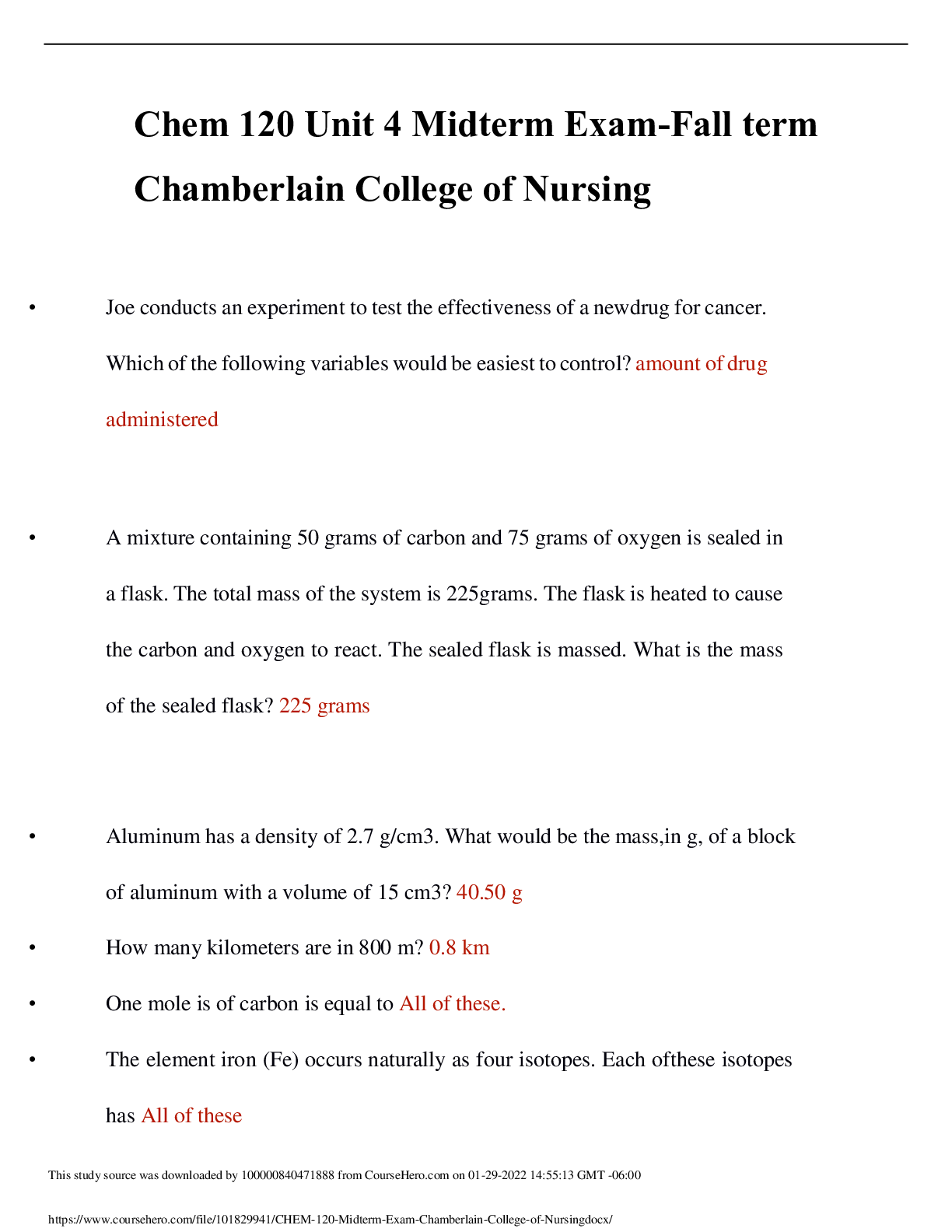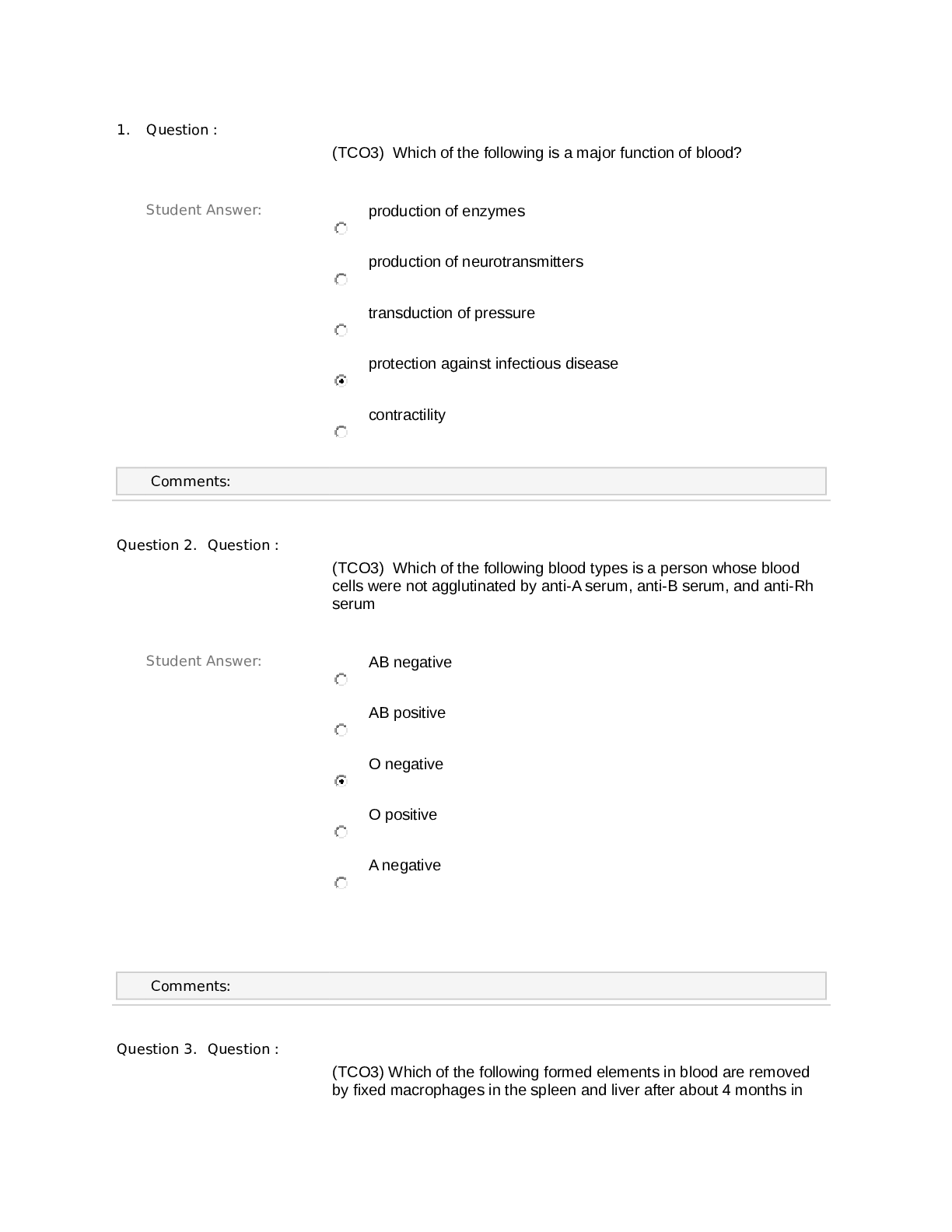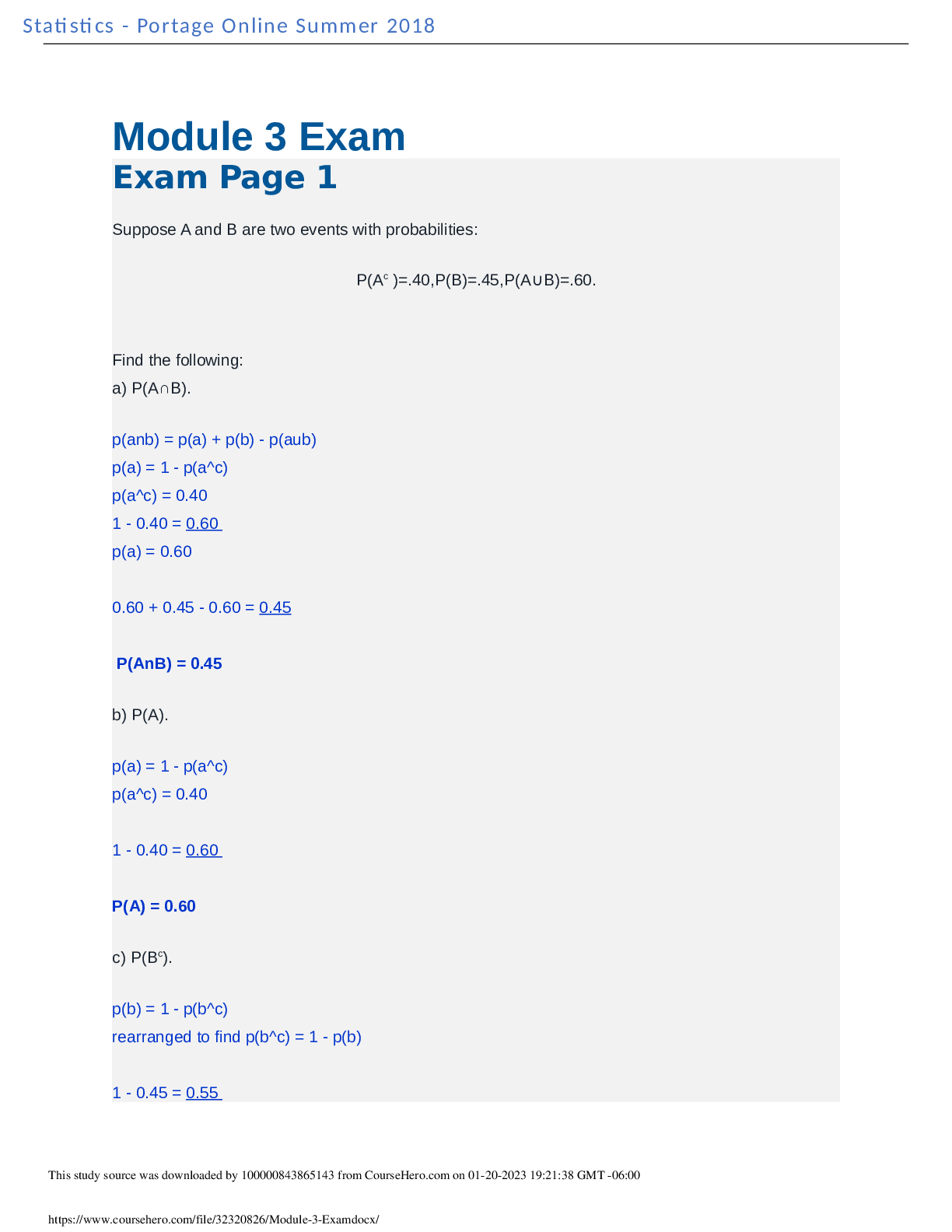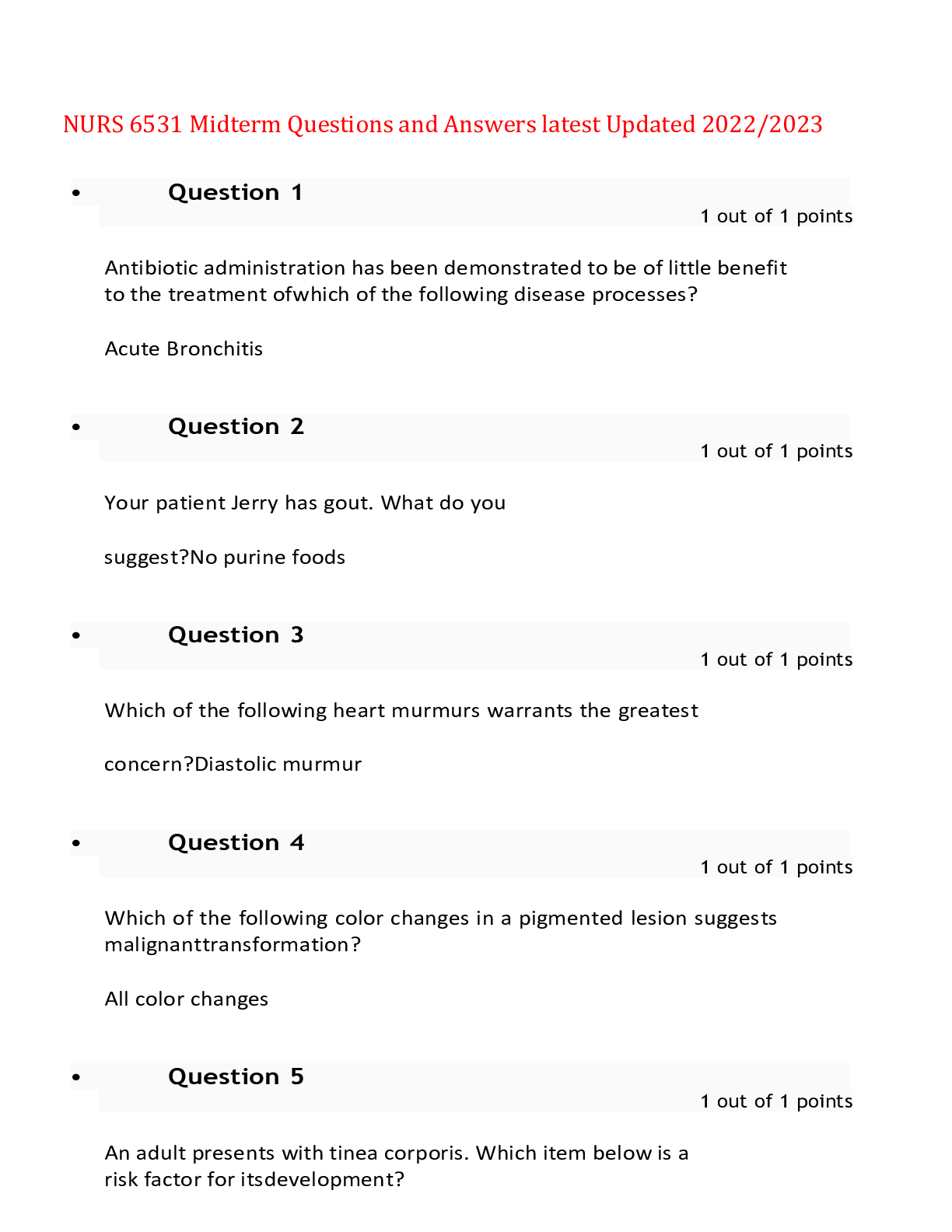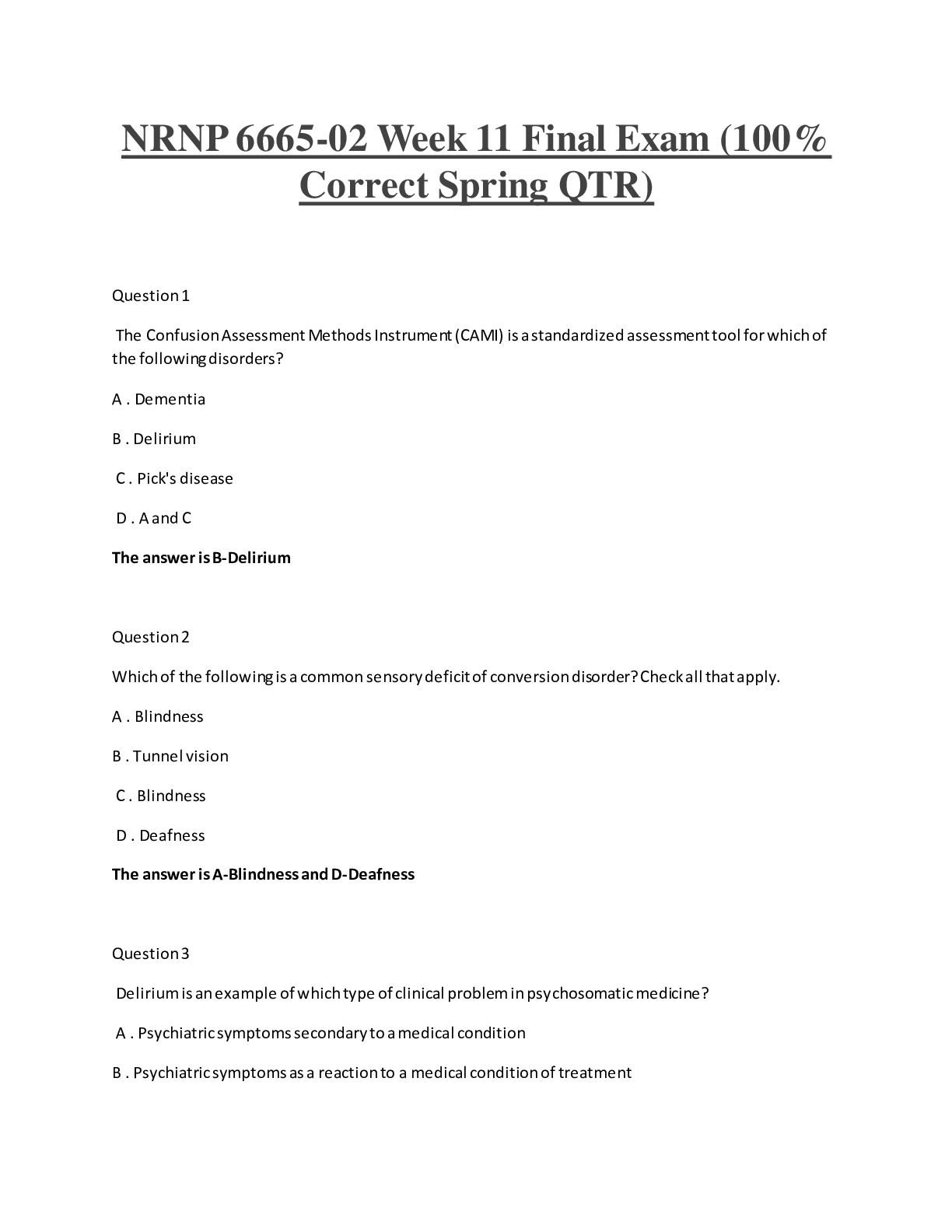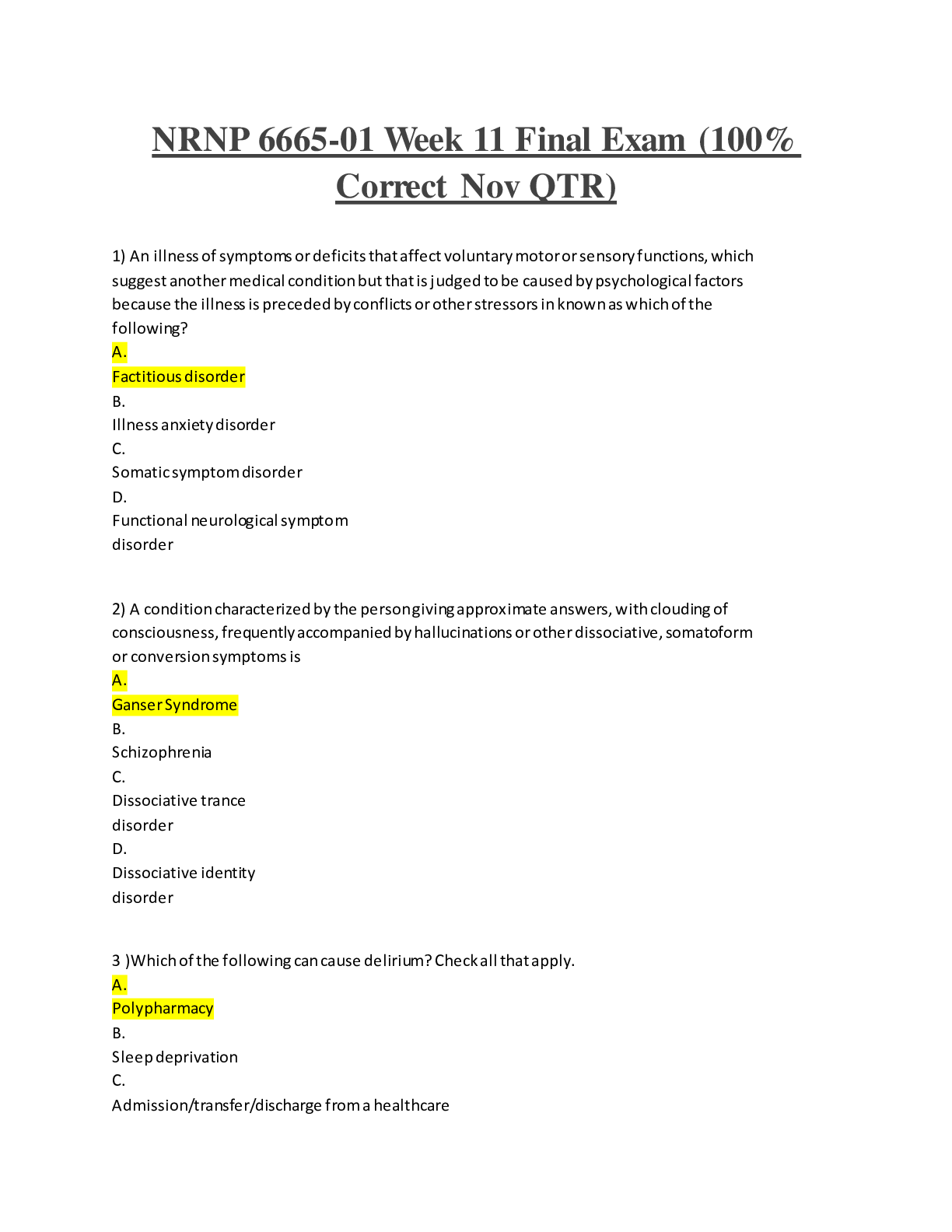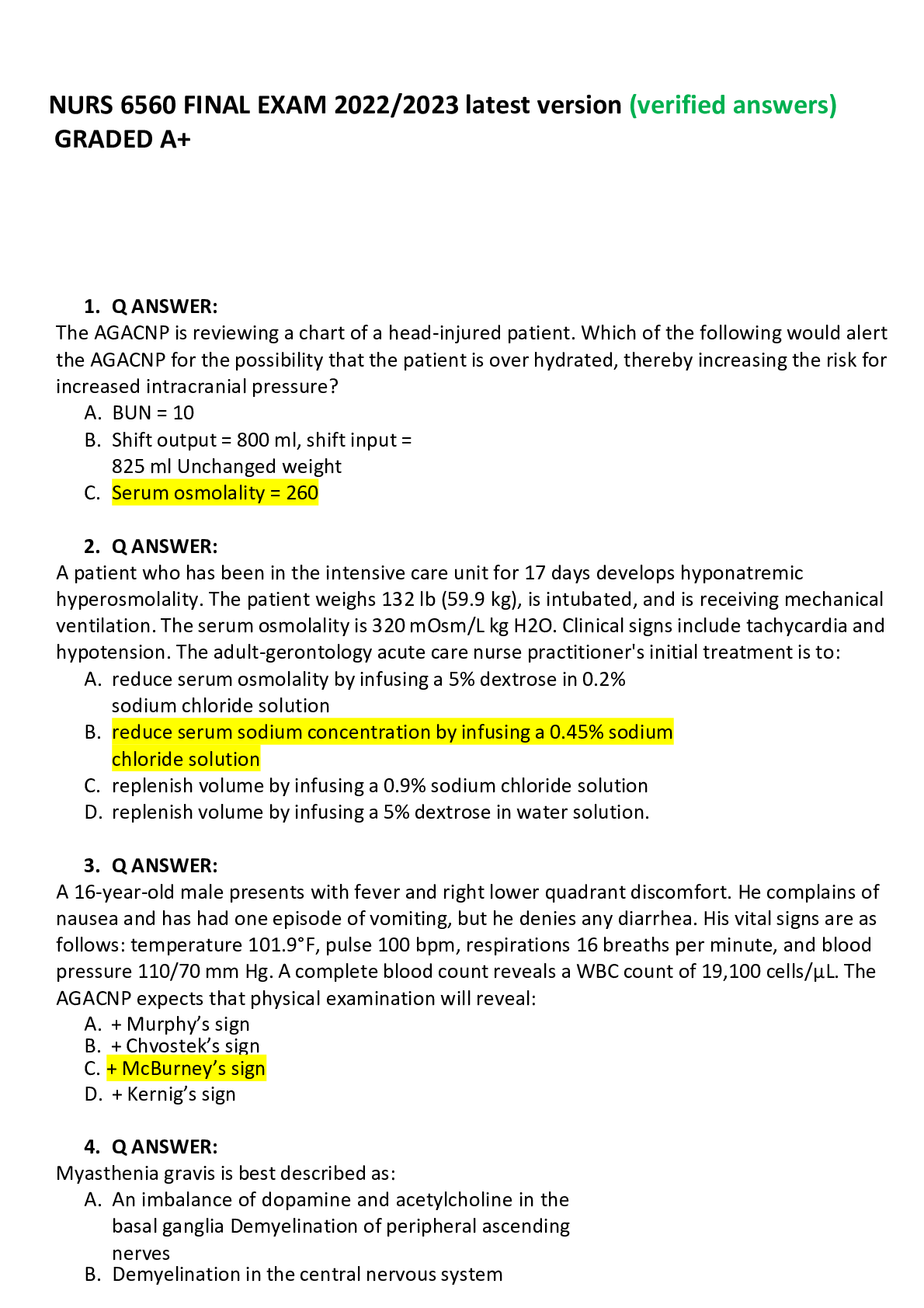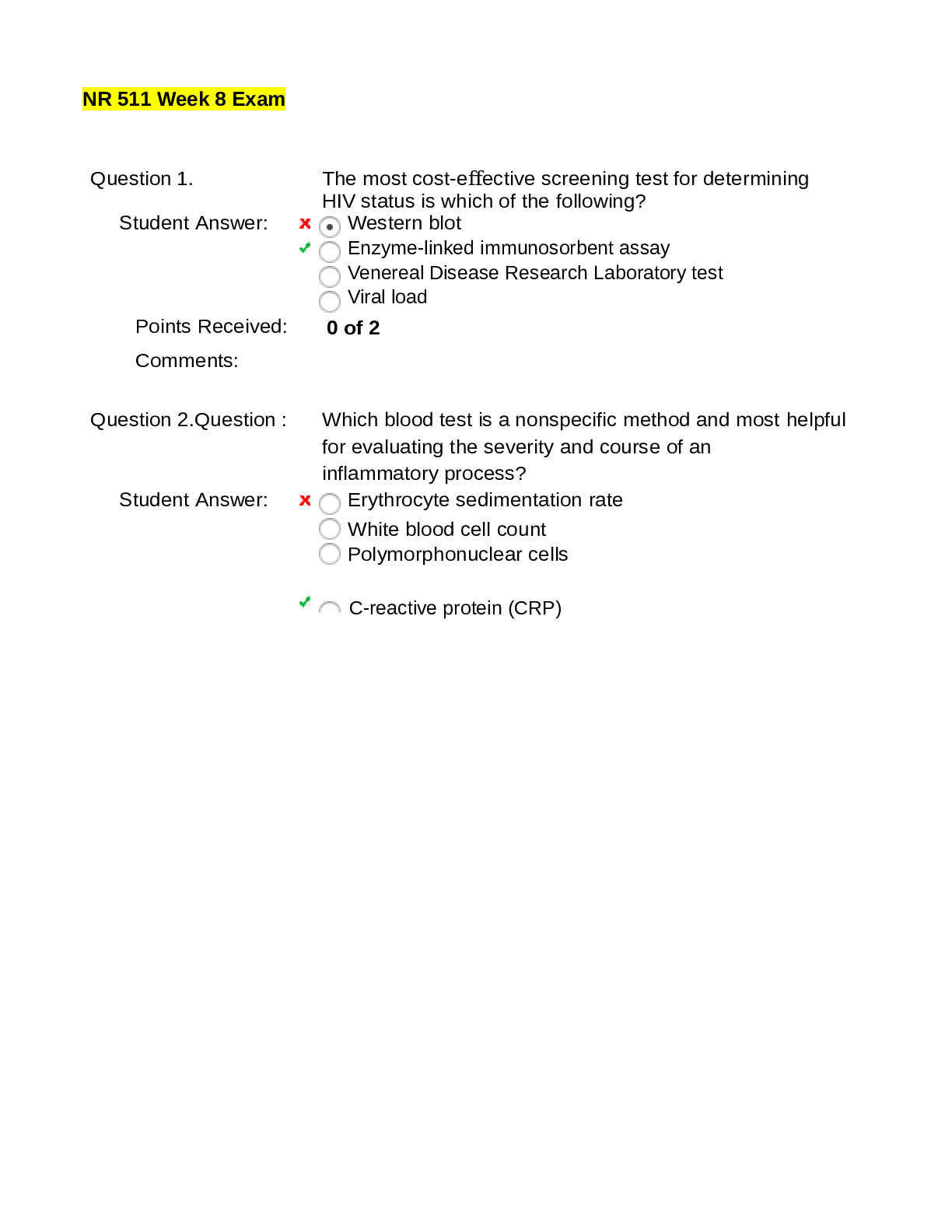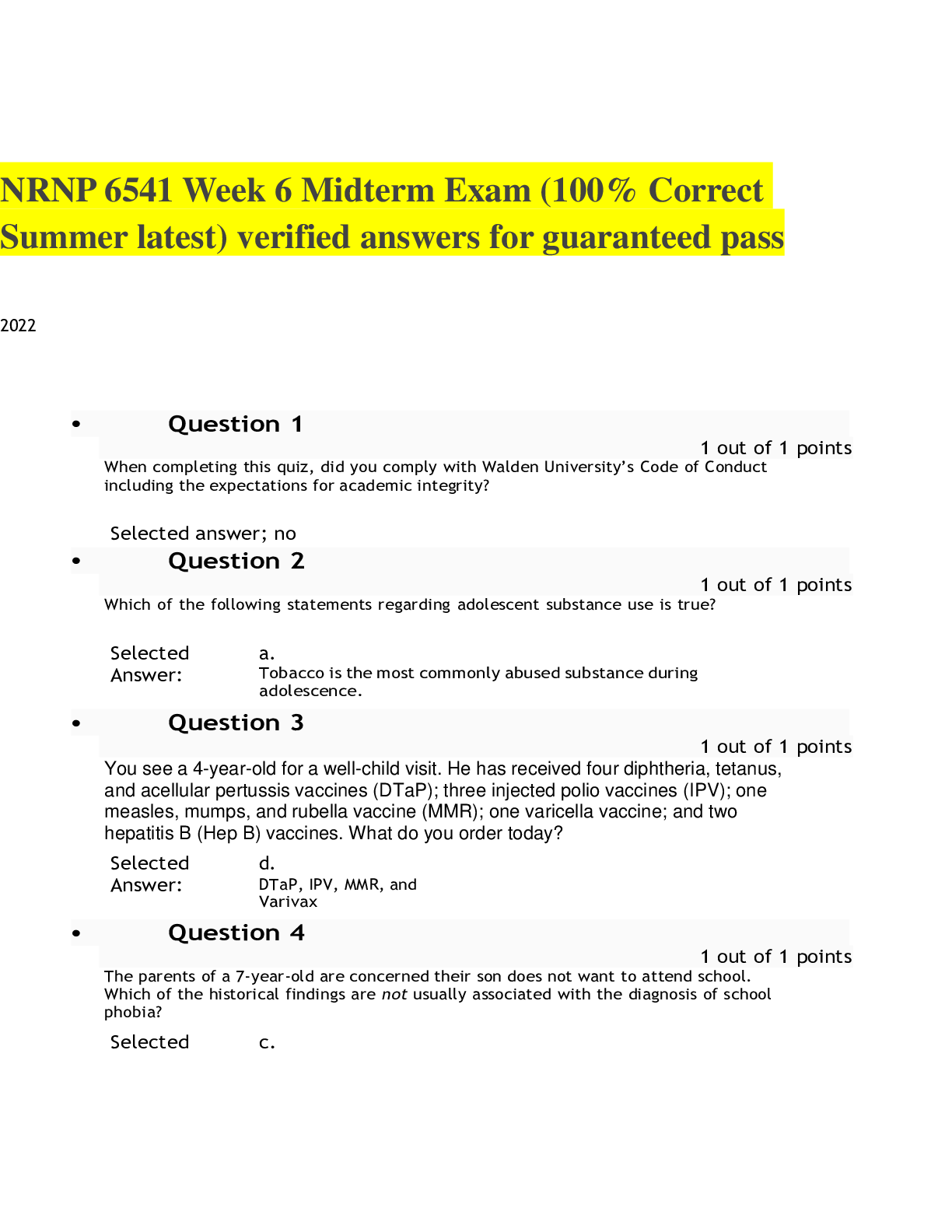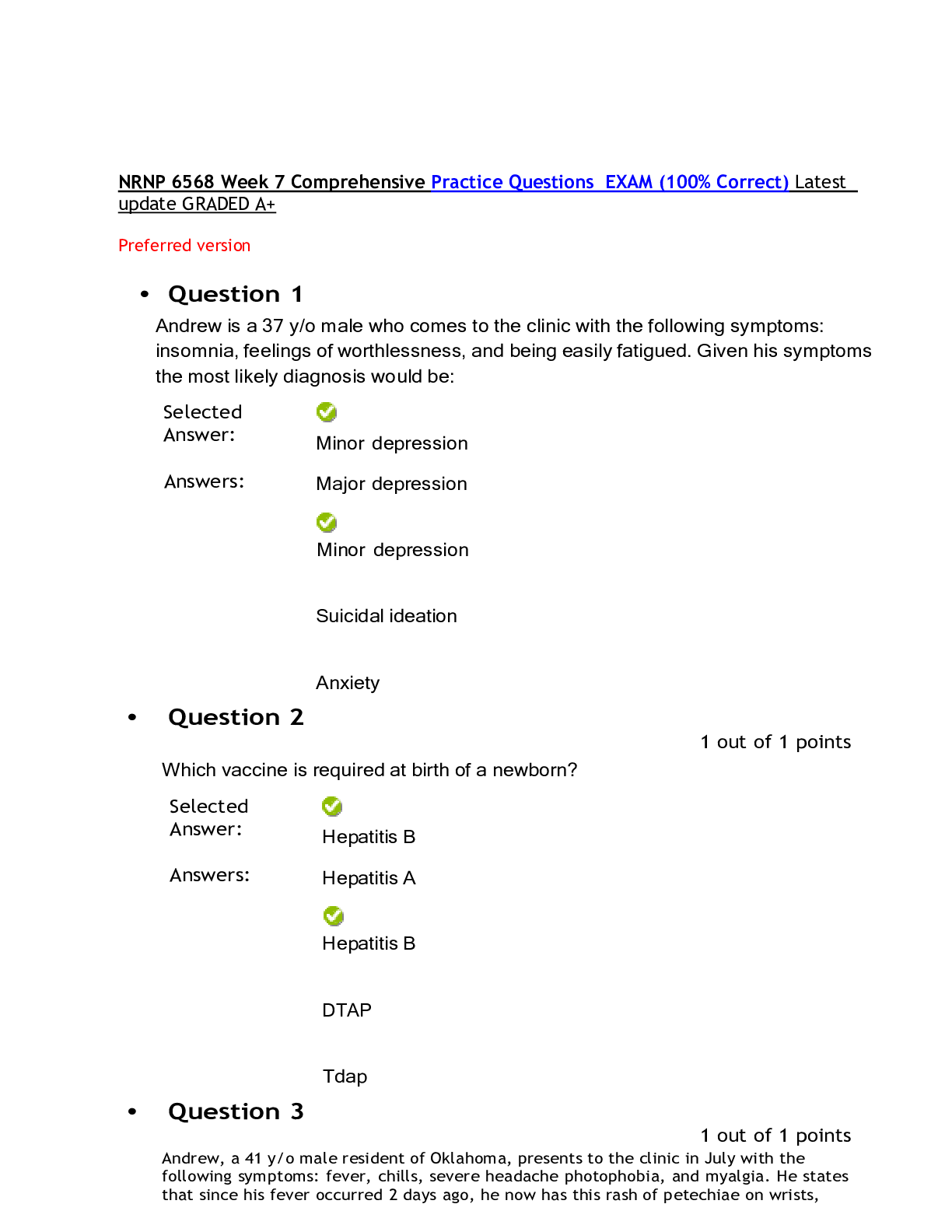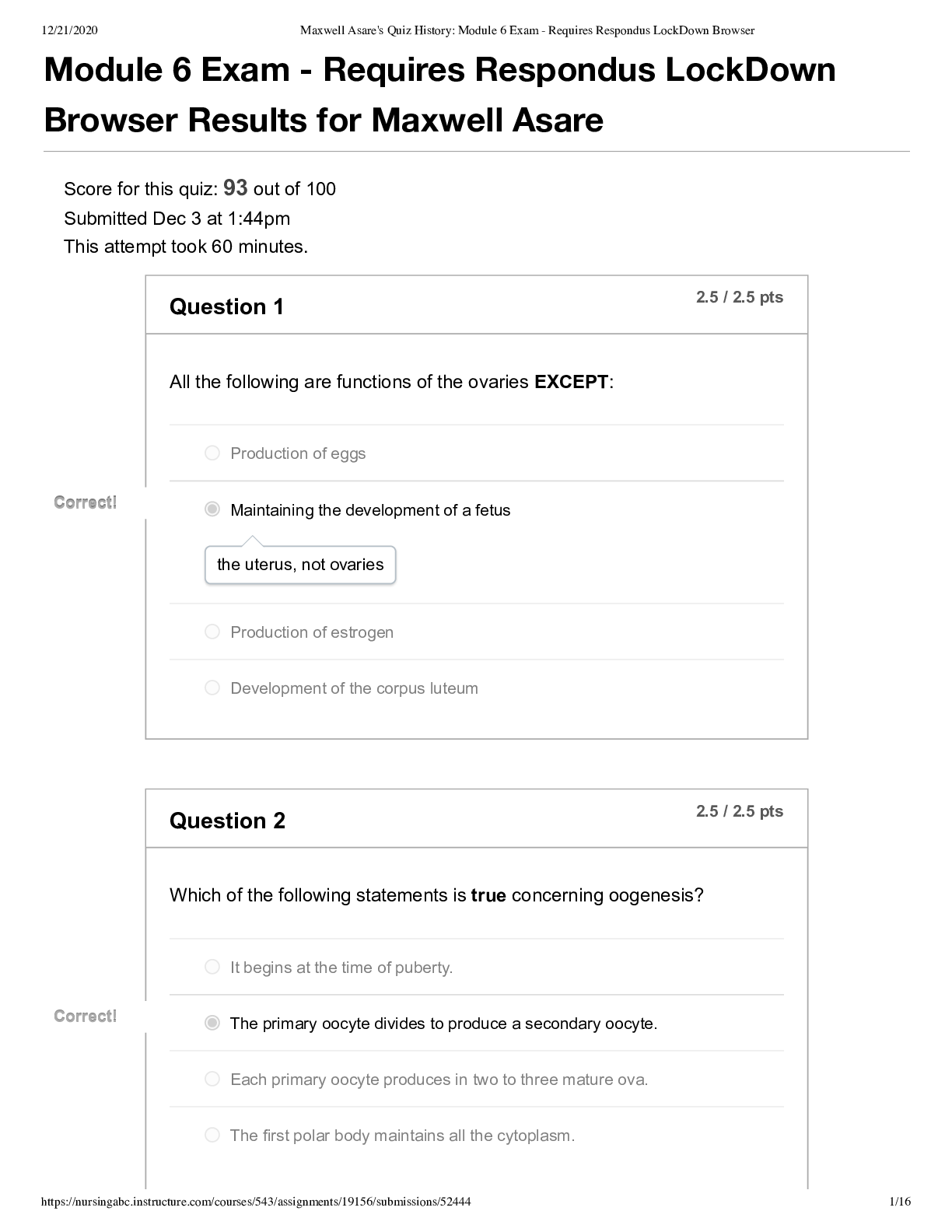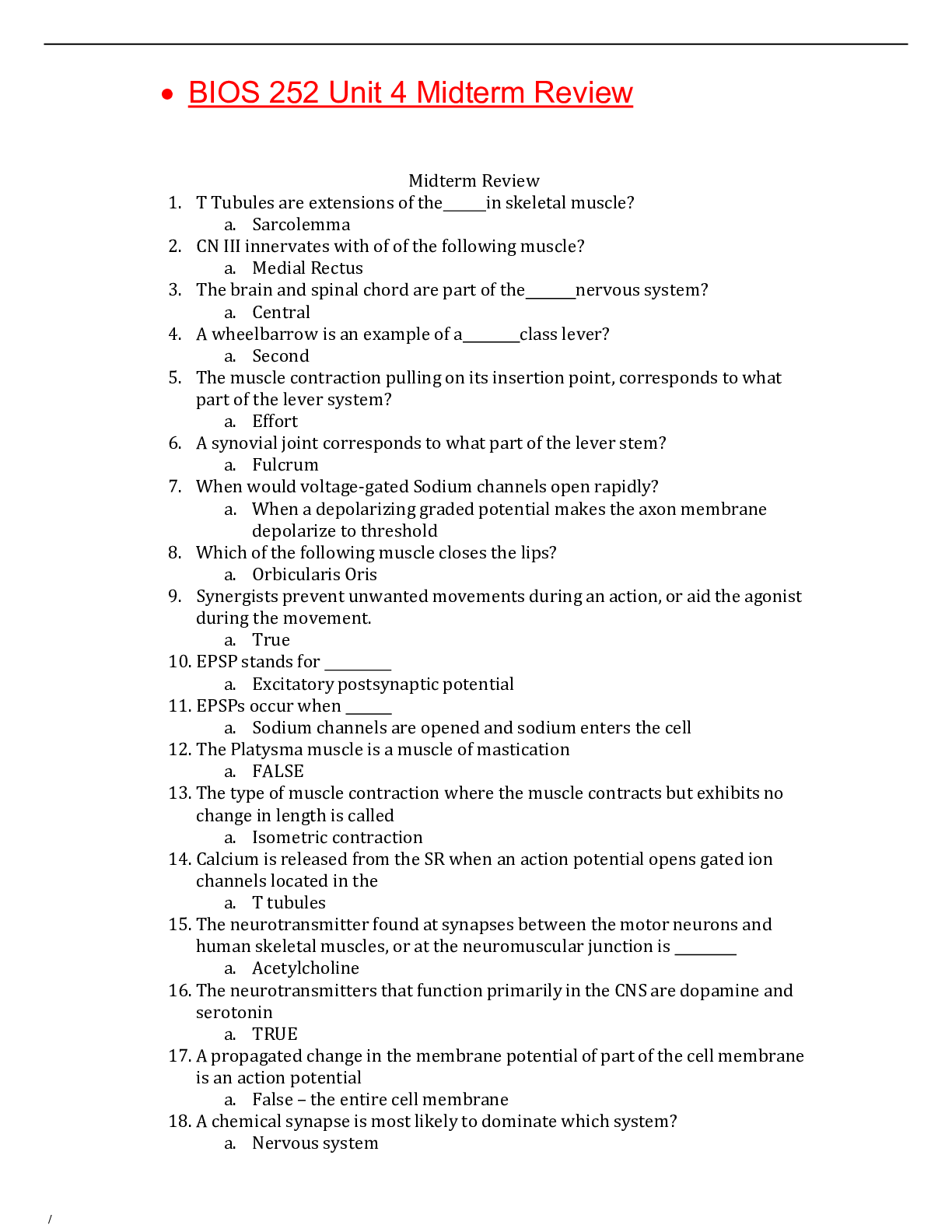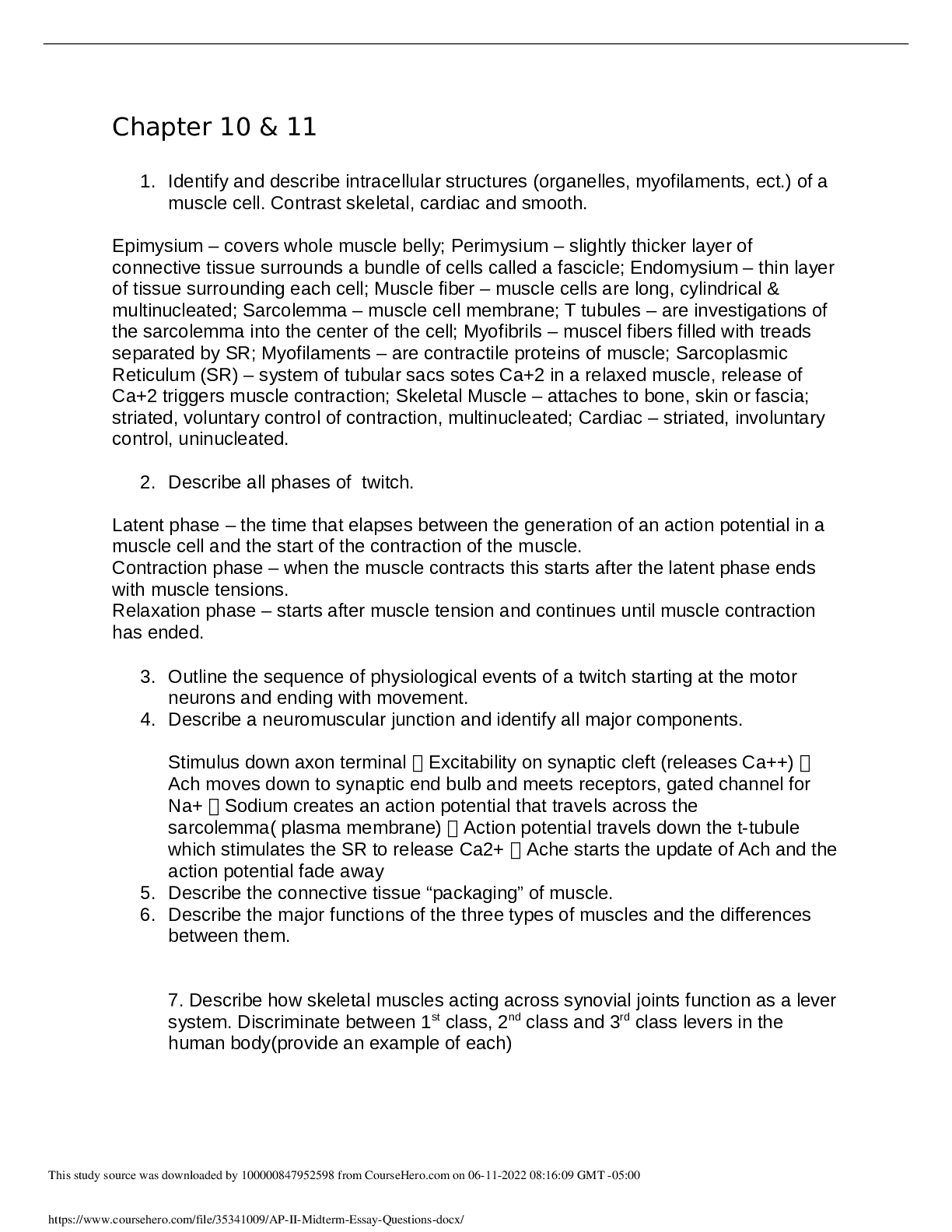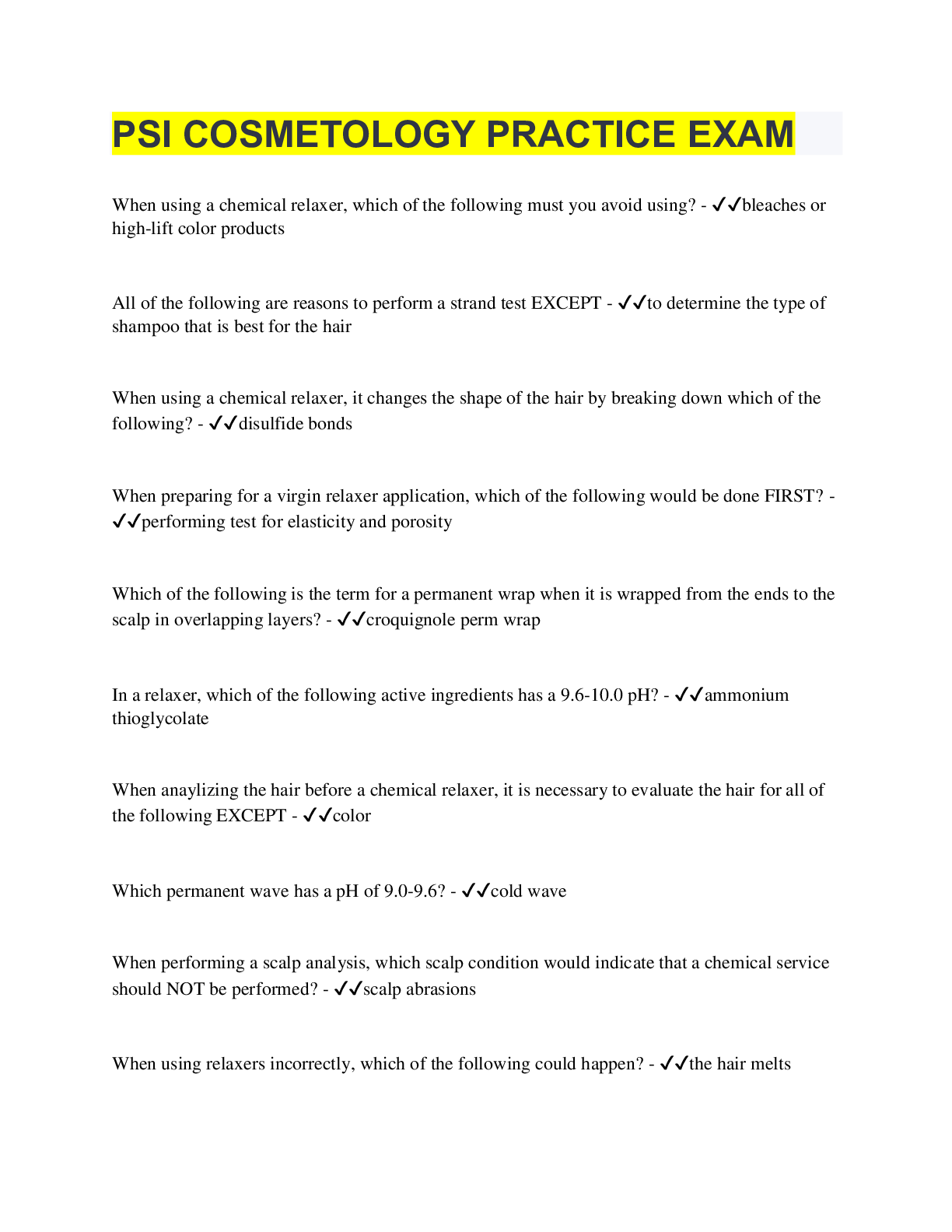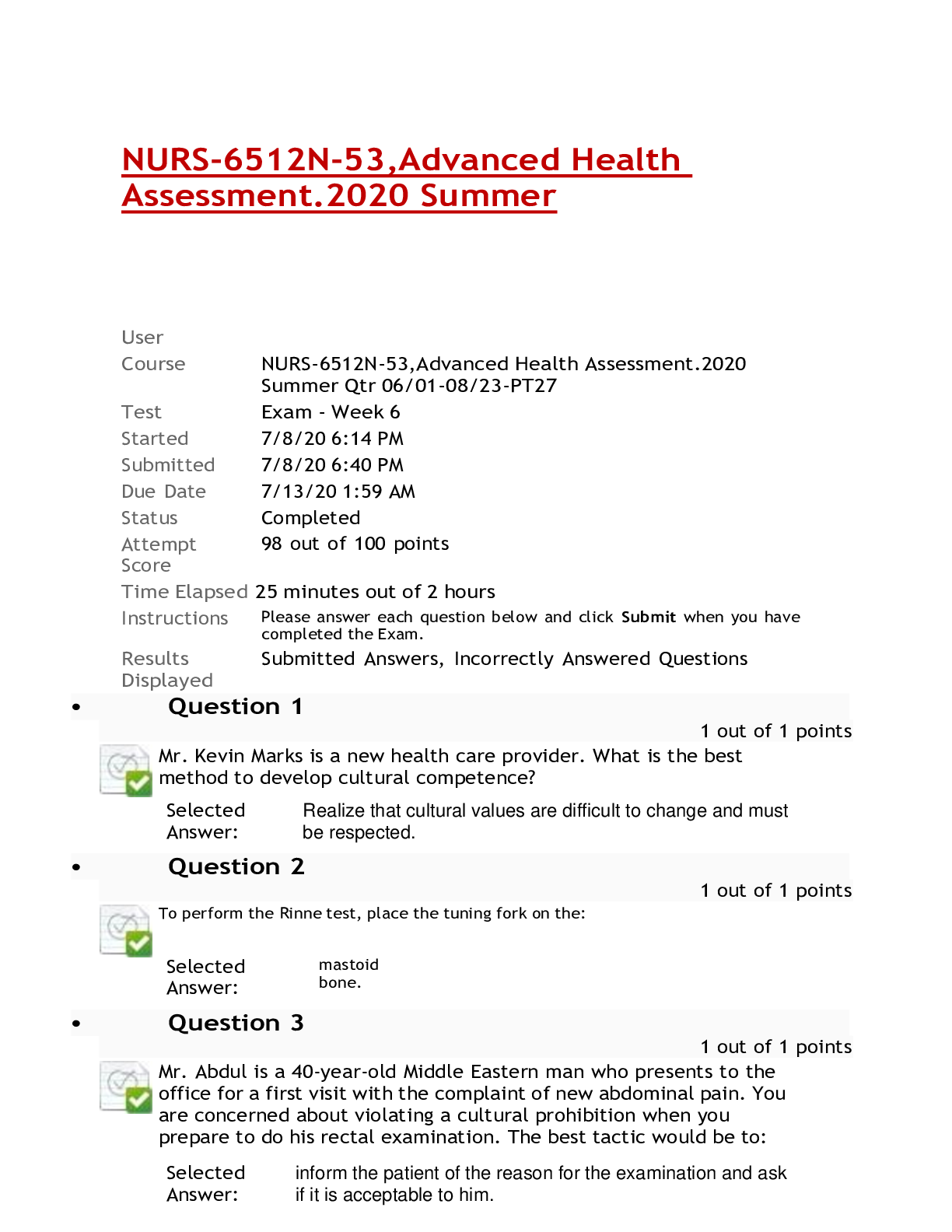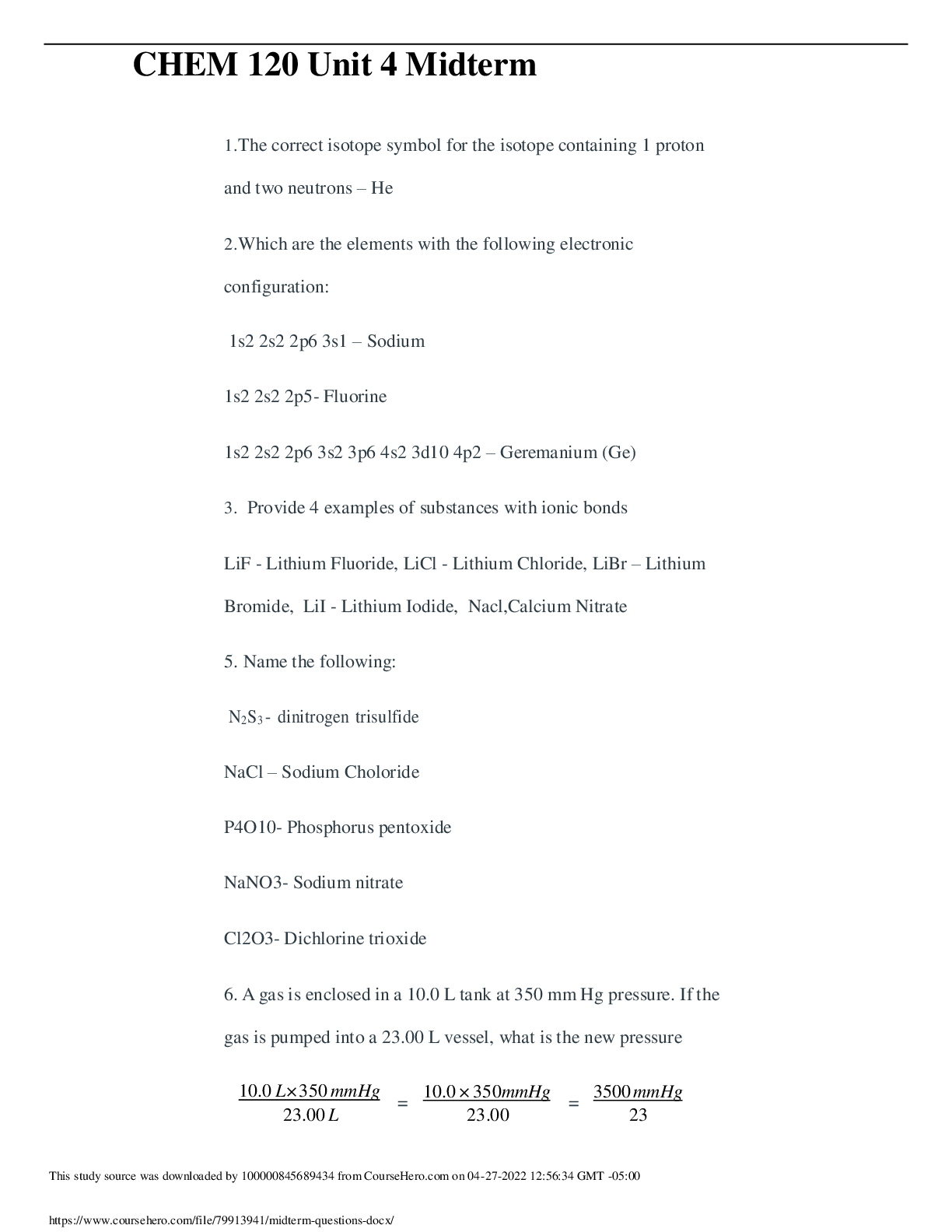BIOS 255 Unit 4 Midterm Exam (100% correct answers)
Document Content and Description Below
1. Question :(TCO3) Which of the following is a major function of blood? Student Answer: production of enzymes production of neurotransmitters transduction of pressure contract... ility Question 2. Question : (TCO3) Which of the following blood types is a person whose blood cells were not agglutinated by anti-A serum, anti-B serum, and anti-Rh serum Student Answer: AB negative AB positive O positive A negative Question 3. Question : (TCO3) Which of the following formed elements in blood are removed by fixed macrophages in the spleen and liver after about 4 months in the circulation? Student Answer: erythrocytes monocytes basophils eosinophils Question 4. Question : (TCO3) A condition in which inadequate intake of vitamin B12 or folic acid cause production of large abnormal red blood cells is called Student Answer: hemorrhagic anemia aplastic anemia pernicious anemia iron deficiency anemia Question 5. Question : (TCO3) Lymph is Student Answer: the same as plasma plasma without the clotting factors formed during the first step in blood clotting pulmonary interstitial fluid Question 6. Question : (TCO3) Which of the following precursor cells give rise to granular leukocytes? Student Answer: megakaryoblast lymphoblast myeloblast none of the selections are correct Question 7. Question : (TCO3) Which of the following substances is an anticoagulant formed by mast cells and basophils? Student Answer: fibrinogen thromboxane A2 prostacyclin plasmin Question 8. Question : (TCO3) Myeloid stem cells reside in Student Answer: the blood the yellow marrow the thymus gland the spleen Question 9. Question : (TCO1) The membrane that surrounds and protects the heart is called the Student Answer: pleura myocardium mediastinum endocardium Question 10. Question : (TCO1) Stimulation of the sympathetic output to the heart would lead to Student Answer: a faster heart rate no effects on cardiac output a ventricular block formation of new erythrocytes Question 11. Question : (TCO1) Which of the following hormones do not increase the heart rate? Student Answer: thyroid hormone epinephrine acetylcholine all of the above hormones Question 12. Question : (TCO1) The difference between a person’s maximum cardiac output and resting cardiac output is called the Student Answer: stroke volume afterload cardiac reserve venous return Question 13. Question : (TCO1) The remnant of the foramen ovale in the adult heart is the Student Answer: foramen magnum interventricular septum fossa ovalis sinoatrial node atrioventricular node Question 14. Question : (TCO1) Which of the following chambers of the heart is surrounded by the thickest layer of myocardium? Student Answer: right atrium left atrium right ventricle left ventricle right auricle Question 15. Question : (TCO1) Which of the following electrocardiogram (ECG) waves represents ventricular repolarization? Student Answer: R wave Q wave P wave S wave T wave Question 16. Question : (TCO1) Elevated levels of in the blood lead to reduced heart rate. Student Answer: potassium calcium epinephrine noradrenalin norepinephrine Question 17. Question : (TCO1) Which layer of the heart is the major contributor to the pumping action of the heart? Student Answer: myocardium epicardium endocardium pericardium serous pericardium Question 18. Question : (TCO2) Which of the following categories of hypertensive drugs lower blood pressure by blocking the formation of angtiotensin II, which results in vasodilation and decreased aldosterone secretion? Student Answer: diuretics ACE inhibitors Beta blockers calcium channel blockers anabolic steroids Question 19. Question : (TCO2) Which of the following categories would an individual with a blood pressure of 130/85 be placed in? Student Answer: normal high normal prehypertension stage 1 hypertension stage 2 hypertension Question 20. Question : (TCO2) Which of the following effectors would NOT be activated as described below in response to hypovolemic shock? Student Answer: adrenal cortex releases aldosterone kidneys conserve salt and water heart rate increases systemic arterioles vasodilate heart contractility increases Question 21. Question : (TCO2) Which of the following types of blood vessels have high pulsing blood pressure? Student Answer: arterioles capillaries venules veins vena cavae Question 22. Question : (TCO2) During embryonic development, blood cells are formed from Student Answer: endodermal cells pluripotent stem cells angioblasts fibroblasts osteoblasts Question 23. Question : (TCO2) Fenestrated capillaries that have small pores are commonly found in the Student Answer: kidneys small intestines choroid plexuses of the neural ventricular system all of the above none of the above Question 24. Question : (TCO2) Which of the following structures are found in veins but NOT in arteries? Student Answer: tunica externa tunica media tunica interna valves lumen Question 25. Question : (TCO2) The largest driving force for pulling fluid from the interstitial spaces back into the capillaries is: Student Answer: interstitial fluid hydrostatic pressure interstitial fluid osmotic pressure blood colloid osmotic pressure blood hydrostatic pressure glomerular hydrostatic pressure Question 26. Question : (TCO3) What is the pulse pressure of a person that has a diastolic pressure of 60 mm Hg with a systolic pressure of 125 mm Hg? Student Answer: 65 mm HG Question 27. Question : (TCO3) Determine the mean arterial pressure for a patient with an average systolic pressure of 120 mm Hg with a mean diastolic pressure of 60 mm Hg: Student Answer: 80 Question 28. Question : (TCO3) What is the resting cardiac output (in liters) of an athlete with a stroke volume of 75 ml and a resting heart rate of 60 beats/minute? Student Answer: CO= SV x HR 4.500 L/Min Question 29. Question : (TCO3) The same athlete during exercise has a heart rate of 180 beats/minute with an increase of stroke volume to 125 ml. What is their cardiac output during exercise? Student Answer: 22.500 L/min Question 30. Question : (TCO3) What is the cardiac cycle for a person with a resting heart rate of 66 beats per minute? Student Answer: Question 31. Question : (TCO3) What is the name of the blood vessel that supplies the face and head (except the brain) with oxygenated blood? Student Answer: supperior sagital sinus Question 32. Question : (TCO3) What is the name of the blood vessel that is the distal extension of the external iliac artery as it enters the leg? Student Answer: Question 33. Question : (TCO3) What is the name of the blood vessel that drains deoxygenated blood from the medial aspect of the forearm? Student Answer: Question 34. Question : (TCO3) What is the name of the vein that is found behind the kneecap on the posterior surface of the leg? Student Answer: Right popliteal Question 35. Question : (TCO3) What is the name of this blood vessel that is highlighted? Student Answer: common carotid Question 36. Question : (TCO3) List and briefly describe the three mechanisms used to reduce blood loss from a damaged blood vessel. Student Answer: Vascular spasm, platelet plug formation, blood clotting (coagulation). vascular spasm is a prompt constriction of a broken vessel. Most immediate protection against blood loss. platelet plug formation They are broken vessels exposes collagen fibers in its walls. Platelet pseudopods stick to damaged vessel and other platelets; pseudopods contract and draw walls of vessel together forming a platelet plug. coagulation-most effective defense against bleeding. This involves the conversion of plasma protein, fibrinogen, into insoluble fibrin threads to form a framework of clot Question 37. Question : (TCO1) Define arrhythmia and discuss different categories of arrhythmias. Student Answer: Arrhythmias are generally divided into two categories: ventricular and supraventricular. Ventricular arrhythmias occur in the lower chambers of the heart the ventricles. Supraventricular arrhythmias occur in the area above the ventricles, usually in the upper chambers of the heart, called the atria. Bradycardia is a very slow heart rate of less than 60 beats per minute. This happens when the electrical impulse that signals the heart to contract is not formed in your hearts natural pacemaker, the sinoatrial node or it is not sent to the heart's lower chambers through the proper channels Ventricular tachycardia is a condition in which the SA node no longer controls the beating of the ventricles. Since the new signal does not move through your heart muscle along the regular route, the heart muscle does not beat normally. Your heartbeat quickens, and you feel as if your heart is "skipping beats." This rhythm may cause severe shortness of breath, dizziness, or fainting. Question 38. Question : (TCO2) What is a portal vein? Describe the hepatic portal circulation and its functional significance Student Answer: Portal vein The portal vein or hepatic portal vein is a blood vessel that carries blood from the gastrointestinal tract and spleen to the liver. This blood is rich in nutrients that have been extracted from food, and the liver processes these nutrients; it also filters toxins that may have been ingested with the food. 75% of total liver blood flow is through the portal vein, with the remainder coming from the hepatic artery proper. The blood leaves the liver to the heart in the hepatic veins. The portal vein is not a true vein, because it conducts blood to capillary beds in the liver and not directly to the heart. It is a major component of the hepatic portal system, one of only two portal venous systems in the body - with the hypophyseal portal system being the other. The portal vein is usually formed by the confluence of the superior mesenteric and splenic veins and also receives blood from the inferior mesenteric, gastric, and cystic veins. The hepatic portal system is the system of veins comprising the hepatic portal vein and its tributaries. It is responsible for directing blood from the region of the gastrointestinal tract between the esophagus and rectum and also includes venous drainage from the supplementary organs such as the spleen and pancreas. Function The portal venous system is responsible for directing blood from parts of the gastrointestinal tract to the liver. Substances absorbed in the small intestine travel first to the liver for processing before continuing to the heart. Not all of the gastrointestinal tract is part of this system. The system extends from about the lower portion of the esophagus to the upper part of the anal canal. It also includes venous drainage from the spleen and pancreas. Many drugs that are absorbed through the GI tract are substantially metabolized by the liver before reaching general circulation. This is referred to as the first pass effect. As a consequence, certain drugs can only be taken via certain routes. For example, nitroglycerin cannot be swallowed because the liver would inactivate the medication, but it can be taken under the tongue or transdermal (through the skin) and thus is absorbed in a way that bypasses the portal venous system. Inversely, dextromethorphan, a cough suppressor, is best taken orally because it needs to be metabolised by the liver into dextrorphan in order to be effective. This latter principle is that of most pro drugs. The use of suppositories is a way to by-pass partially the portal vein: the upper 1/3 of the rectum is drained into the portal vein while the lower 2/3 are drained into the internal iliac vein that goes directly in the inferior vena cava (thus by-passing the liver). Blood flow to the liver is unique in that it receives both oxygenated and (partially) deoxygenated blood. As a result, the partial gas pressure of oxygen (pO2) and perfusion pressure of portal blood are lower than in other organs of the body. Blood passes from branches of the portal vein through cavities between "plates" of hepatocytes called sinusoids. Blood also flows from branches of the hepatic artery and mixes in the sinusoids to supply the hepatocytes with oxygen. This mixture percolates through the sinusoids and collects in a central vein which drains into the hepatic vein. The hepatic vein subsequently drains into the inferior vena cava. The hepatic artery provides 30 to 40% of the oxygen to the liver, while only accounting for 25% of the total liver blood flow. The rest comes from the partially deoxygenated blood from the portal vein. The liver consumes about 20% of the total body oxygen when at rest. That is why the total liver blood flow is quite high, at about 1 litre a minute and up to two litres a minute. That is on average one fourth of the average cardiac output at rest. Large veins that are considered part of the portal venous system are the: Hepatic portal vein Splenic vein Superior mesenteric vein Inferior mesenteric vein The superior mesenteric vein and the splenic vein come together to form the actual hepatic portal vein. The inferior mesenteric vein connects in most people on the splenic vein, but in others, it is known to connect on the portal vein or the superior mesenteric vein. The portal venous system corresponds to areas supplied by the celiac trunk, the superior mesenteric artery, and the inferior mesenteric artery [Show More]
Last updated: 1 year ago
Preview 1 out of 14 pages
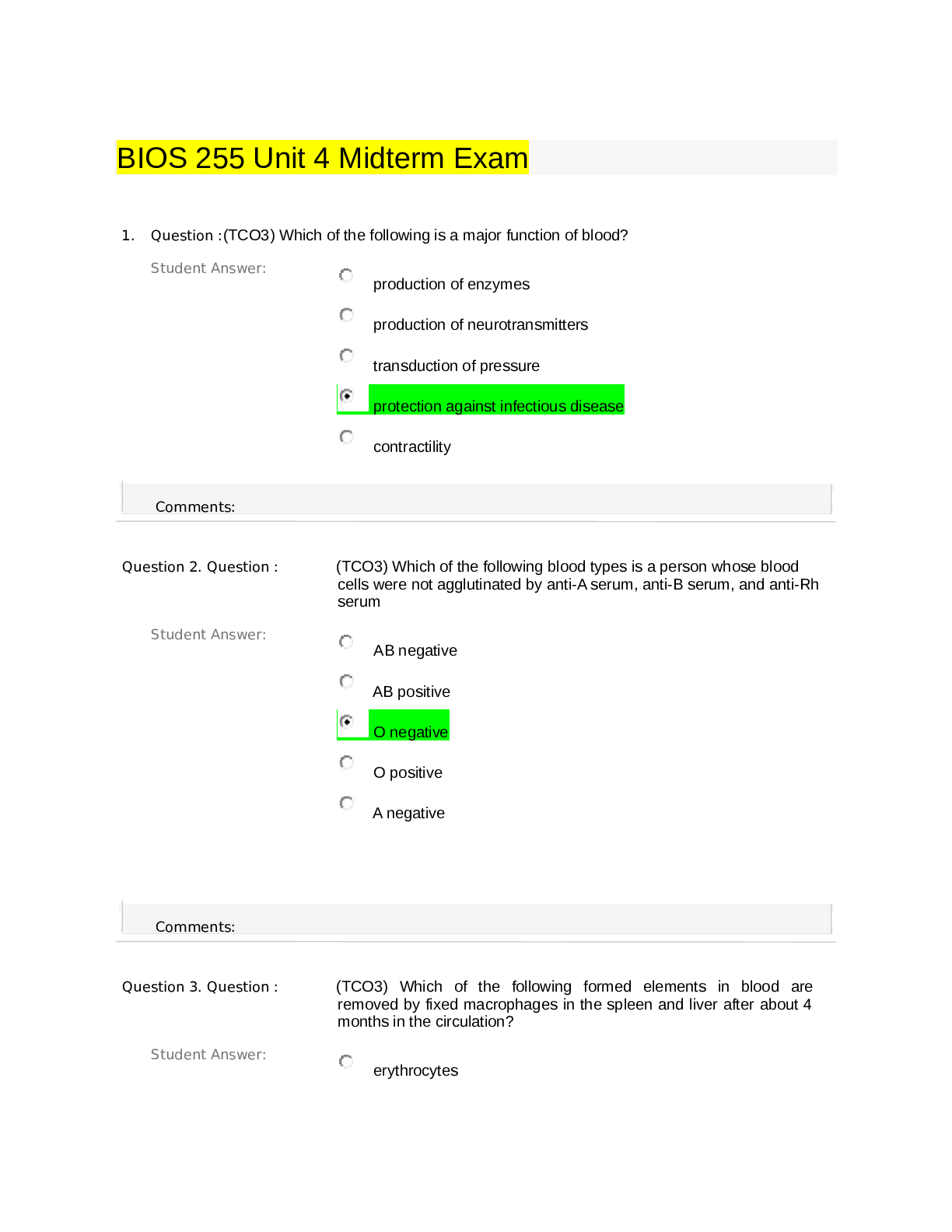
Reviews( 0 )
Document information
Connected school, study & course
About the document
Uploaded On
Nov 02, 2022
Number of pages
14
Written in
Additional information
This document has been written for:
Uploaded
Nov 02, 2022
Downloads
0
Views
70
.png)




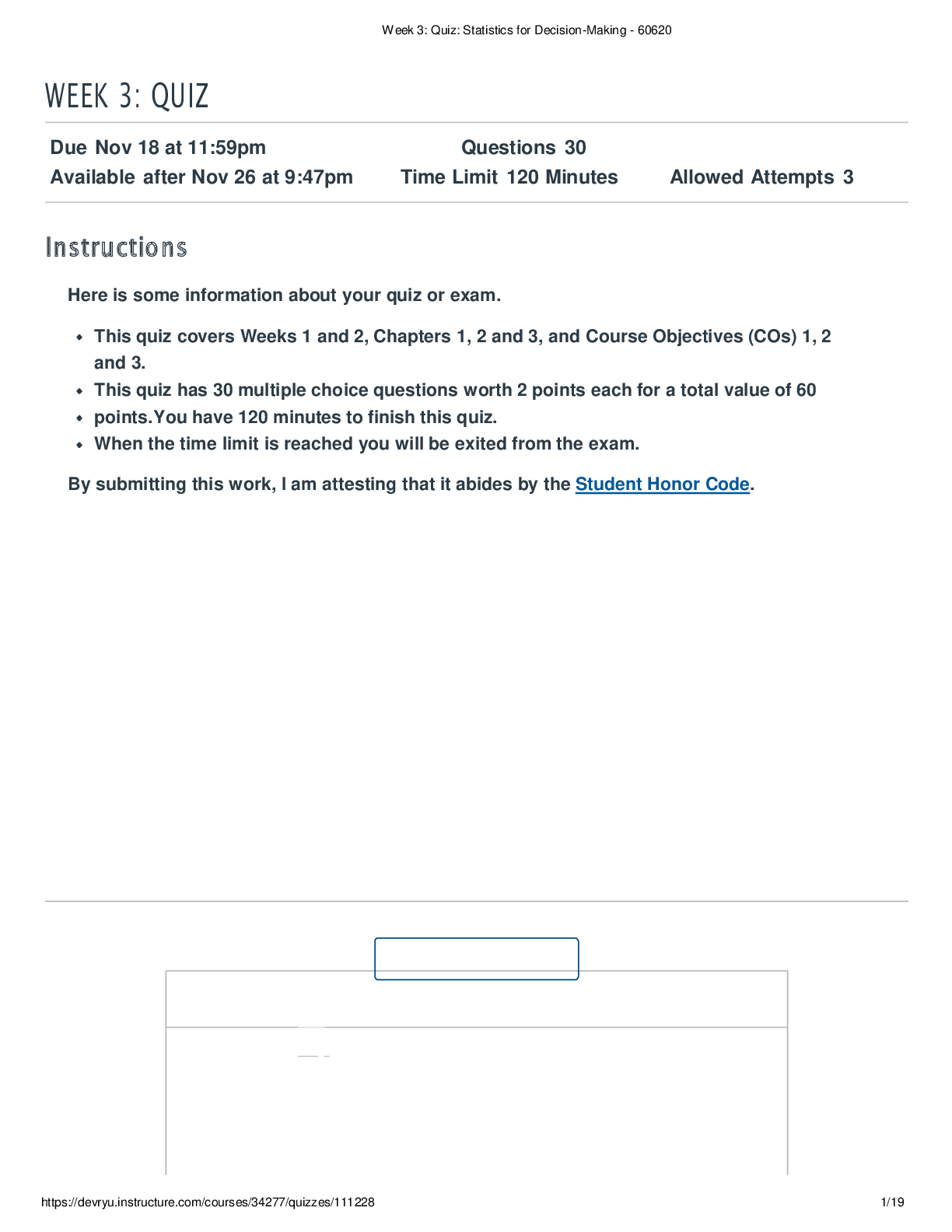

.png)










